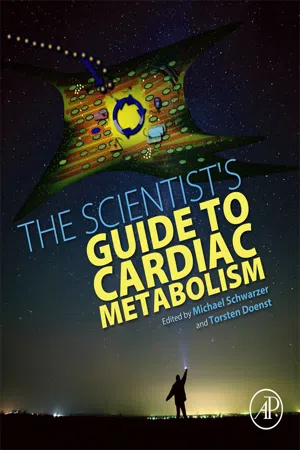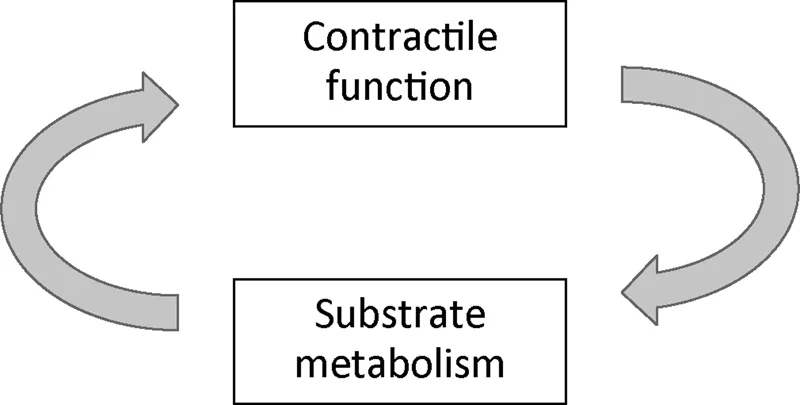
This is a test
- 240 pages
- English
- ePUB (mobile friendly)
- Available on iOS & Android
eBook - ePub
The Scientist's Guide to Cardiac Metabolism
Book details
Book preview
Table of contents
Citations
About This Book
The Scientists Guide to Cardiac Metabolism combines the basic concepts of substrate metabolism, regulation, and interaction within the cell and the organism to provide a comprehensive introduction into the basics of cardiac metabolism.
This important reference is the perfect tool for newcomers in cardiac metabolism, providing a basic understanding of the metabolic processes and enabling the newcomer to immediately communicate with the expert as substrate/energy metabolism becomes part of projects.
The book is written by established experts in the field, bringing together all the concepts of cardiac metabolism, its regulation, and the impact of disease.
- Provides a quick and comprehensive introduction into cardiac metabolism
- Contains an integrated view on cardiac metabolism and its interrelation in metabolism with other organs
- Presents insights into substrate metabolism in relation to intracellular organization and structure as well as whole organ function
- Includes historical perspectives that reference important investigators that have contributed to the development of the field
Frequently asked questions
At the moment all of our mobile-responsive ePub books are available to download via the app. Most of our PDFs are also available to download and we're working on making the final remaining ones downloadable now. Learn more here.
Both plans give you full access to the library and all of Perlego’s features. The only differences are the price and subscription period: With the annual plan you’ll save around 30% compared to 12 months on the monthly plan.
We are an online textbook subscription service, where you can get access to an entire online library for less than the price of a single book per month. With over 1 million books across 1000+ topics, we’ve got you covered! Learn more here.
Look out for the read-aloud symbol on your next book to see if you can listen to it. The read-aloud tool reads text aloud for you, highlighting the text as it is being read. You can pause it, speed it up and slow it down. Learn more here.
Yes, you can access The Scientist's Guide to Cardiac Metabolism by Michael Schwarzer,Torsten Doenst in PDF and/or ePUB format, as well as other popular books in Biological Sciences & Molecular Biology. We have over one million books available in our catalogue for you to explore.
Information
Chapter 1
Introduction to Cardiac Metabolism
Michael Schwarzer
Torsten Doenst Department of Cardiothoracic Surgery, Jena University Hospital, Friedrich Schiller University of Jena, Jena, Germany
Abstract
In order for the heart to sustain its regular heartbeat, it needs a constant supply of energy for contraction. Cardiac metabolism comprises all processes involved in the biochemical conversion of molecules within the cell utilizing energy substrates. These substrates are mainly fatty acids, glucose, and lactate, but as a true metabolic omnivore the heart is able to utilize them all for energy production. In addition, cardiac metabolism comprises all biochemical processes of the cell aimed at the generation of building blocks for cell maintenance, biosynthesis, and cellular growth. This chapter provides orientation for optimal use of and navigation through this book.
Keywords
cardiac metabolism
contractile function
substrate metabolism
In order for the heart to sustain its regular heartbeat, it needs a constant supply of energy for contraction [1]. This energy comes primarily from the hydrolysis of ATP, which is generated within the cardiomyocyte by utilizing various competing substrates and oxygen, which again are supplied by coronary flow [2,3]. Cardiac metabolism therefore comprises all processes involved in the biochemical conversion of molecules within the cell utilizing energy substrates. In addition, cardiac metabolism comprises all biochemical processes of the cell aimed at the generation of building blocks for cell maintenance, biosynthesis, and cellular growth.
There is an intimate connection between cardiac metabolism and contractile function, which is illustrated schematically in Fig. 1.1. As simple as this illustration, which stems originally from Heinrich Taegtmeyer, appears as complex is its meaning [4]. It is clear that changes in contractile function require changes in cardiac metabolism as more power needs more fuel, that is, ATP, and less power needs less fuel. The schematic also illustrates that contractile function is directly influenced by metabolism. Again, if ATP is limited (e.g., during ischemia), it is easily envisioned that contractile function seizes. However, the scheme finally encompasses myocardial metabolism as potential target for treating contractile dysfunction [5]. Considering that metabolic processes also influence biosynthesis, it becomes clear that metabolism is a prime target of investigations for nearly all physiologic and pathologic states of the heart, may it be ischemia/reperfusion, diabetes, hypertrophy, and acute and chronic heart failure [6].

Figure 1.1 Schematic illustration of the interrelation of cardiac contractile function and substrate metabolism. Adapted from Ref. [4].
In order to develop an understanding for these interrelations and to obtain basic knowledge about the methods and tools used for the investigation of (cardiac) metabolism, we have compiled this book. It reflects a selection of chapters geared toward the transfer of principles in cardiometabolic research. The book does not claim to be complete, but its content should make the reader quickly understand most of the specific topics he or she intends to specialize in and to be better able to put the personal investigations into perspective.
In Chapter 2, Jan Glatz and Miranda Nabben begin with illustrating basics in metabolically relevant biochemistry. They show that metabolism is tightly coupled to all major types of biomolecules as virtually every biomolecule can be used as a substrate or pathway component in metabolism. Carbohydrates and fatty acids are the main substrates used to produce ATP. Amino acids and nucleotides are mainly used to build proteins and nucleic acids. However, all biomolecules come with specific characteristics and even when they are “exclusively” used as substrate for ATP generation, their biochemical influence on other cellular processes needs to be taken into account as well. Furthermore, the properties of biomolecules influence their transport as well as their import into the cell or into cellular substructures, such as mitochondria. Fatty acids as lipophilic compounds are not readily soluble in the aqueous blood and cytoplasm. Carbohydrates, nucleic acids, and amino acids are more hydrophilic and may not cross membranes without help. Thus, it is important to be aware of the properties of biomolecules and their biochemistry. This chapter introduces the reader to the biochemical properties of the major classes of molecules and illustrates their behavior.
In Chapter 3, Bernd Niemann and Susanne Rohrbach address metabolically relevant cell biology and illustrate the roles of intracellular organelles for cardiac metabolism. In this chapter, the roles of all major cellular organelles with respect to cardiac metabolism are described. The reader may find that both fatty acid oxidation and phospholipid ether biosynthesis may be peroxisomal processes and that the endoplasmatic/sarcoplasmatic reticulum has a major role in calcium homeostasis which influences cardiac contractility as well as metabolic enzyme activities. While the role of ribosomes seems to be better known, the importance of transport systems and vesicle pools may have been less recognized and their role in glucose and fatty acid uptake, fission and fusion of mitochondria is highlighted. Finally, the authors elegantly explain the different modes of cell death known as apoptosis, autophagy, necrosis, and necroptosis. They describe their causes, regulations, and their differences.
In Chapter 4, together with Christina Werner, we address principle metabolic pathways and metabolic cycles as they relate to energy production and building-block generation in the heart. This chapter covers the important biochemical parts of substrate use in cardiac metabolism. The contents of this chapter represent another fundamental component of cardiac metabolism, as it demonstrates how glucose and fatty acids as the main substrates are metabolized. Here, the connection between different pathways is illustrated and the importance of the citric acid cycle for the generation of reducing equivalents as well as for building blocks for biosynthetic processes becomes readily visible. The role of the respiratory chain as acceptor of reducing equivalents, as consumer of oxygen and most importantly as the main site of ATP production is made apparent. Furthermore, anaplerosis as mechanism to “refill” exploited moieties within metabolic cycles is introduced and the interrelation of hexosamine biosynthetic pathway, pentose phosphate pathway, and glycolysis is presented as well as the influence of fatty acid oxidation on glucose use and vice versa. Understanding of the principles explained in this chapter is essential to follow the metabolic path of substrates in an organism.
Louis Hue, Luc Bertrand, and Christophe Beauloye then address the principles of how the previously described cycles and pathways are regulated and how metabolism is controlled. Cardiac metabolism must never stop and needs to be adjusted to substrate availability, hormonal regulation, and workload. The authors elegantly describe how metabolic pathways are organized and controlled. Furthermore, they discuss how short- and long-term control of enzyme and pathways activity is achieved and how flux may be controlled. With flux control, they distinguish between two general mechanisms: control by supply as a “push mechanism” or control by demand as a “pull mechanism.” Another way to control substrate metabolism is achieved by substrate competition and interaction, which seems to be the most sensitive regulation seen in metabolism. Chapter 5 offers the reader a thorough understanding of the regulations and interdependencies of cardiac metabolic pathways and cycles.
The previously mentioned information is strictly focused on processes ongoing in the mature, adult heart. However, metabolism undergoes massive changes during development. These changes are described by Andrea Schrepper in Chapter 6. The adult heart consumes preferentially fatty acids followed by lower amounts of glucose, lactate, and ketone bodies. In contrast, embryonic, fetal, and neonatal hearts; considerably deviate from the adult situation. Oxygen availability is frequently limited and substrate provision differs significantly from the adult situation. Glucose is the major substrate in these hearts with glycolysis as the main process for ATP generation. With birth, the heart has to adapt quickly to the abundance of fatty acids and increased oxygen availability. The change from glucose as the preferred substrate in the fetus to the adult situation is described in this chapter. Furthermore in the aging organism, cardiac metabolism changes again and the heart has to cope with increasing limitations in metabolism and function. The findings in cardiac metabolism in the aging heart are also discussed.
With Chapters 7 and 8, we enter the realm of methods and models. Together with M...
Table of contents
- Cover
- Title page
- Table of Contents
- Copyright
- List of Contributors
- Foreword
- Chapter 1: Introduction to Cardiac Metabolism
- Chapter 2: Basics in Metabolically Relevant Biochemistry
- Chapter 3: Metabolically Relevant Cell Biology – Role of Intracellular Organelles for Cardiac Metabolism
- Chapter 4: Metabolic Pathways and Cycles
- Chapter 5: Principles in the Regulation of Cardiac Metabolism
- Chapter 6: Cardiac Metabolism During Development and Aging
- Chapter 7: Methods to Investigate Cardiac Metabolism
- Chapter 8: Models to Investigate Cardiac Metabolism
- Chapter 9: Diurnal Variation in Cardiac Metabolism
- Chapter 10: Nutritional and Environmental Influences on Cardiac Metabolism and Performance
- Chapter 11: Influence of Ischemia-Reperfusion Injury on Cardiac Metabolism
- Chapter 12: Metabolic Remodeling in the Development of Heart Failure
- Chapter 13: Energetics in the Hypertrophied and Failing Heart
- Chapter 14: Cardiac Metabolism – The Link to Clinical Practice
- Chapter 15: Historical Perspectives
- Subject Index